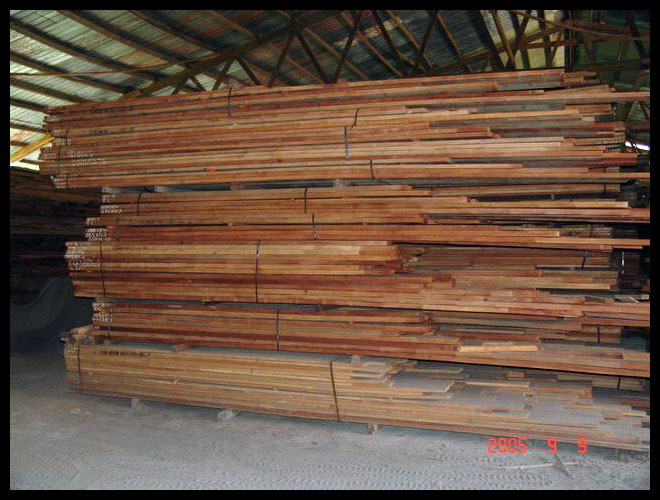Kembang Semangkok (KSK)

INTRODUCTION
The Standard Malaysian Name for the timber of Scaphium spp. (Sterculiaceae). The ASEAN Standard Name for the timber, which is of Thai origin, is SAMRONG. The timber is known as KAPAS-KAPASAN in Indonesia. There are four species of kembang semangkok found in Peninsular Malaysia. Vernacular names applied include kembang semangkok (Peninsular Malaysia, Sabah and Sarawak) with various epithets. Major species include S. linearicarpum, S. longiflorum, S. macropodum and S. scaphigerum. The sapwood is lighter in shade and merges gradually into the heartwood, which is yellow-brown, light buff or light brown.
DENSITY
The timber is soft to moderately soft and light to moderately heavy with a density of 515-755 kg/m3 air dry. It is classified under Light Hardwood in Malaysia.
NATURAL DURABILITY
The timber is moderately durable under exposed conditions. The sapwood appears to be susceptible to blue stain fungal infection and to powder-post beetle attacks.
PRESERVATIVE TREATMENT
The timber is very easily treated with preservatives.
TEXTURE
Texture is slightly coarse and uneven, due to the broad rays and wide layers of parenchyma. Grain is straight or shallowly interlocked.
STRENGTH PROPERTIES
The timber falls into Strength Group C (Burgess, 1958) or SG 3 (MS 544:Part 2:2001).
Strength Properties of Kembang Semangkok (S. macropodum)
Test Condition | Modulus of Elasticity(MPa) | Modulus of Rupture(MPa) | Compression parallel to grain (MPa) | Compression perpendicular to grain (MPa) | Shear strength(MPa) |
Green | 15,500 | 76 | 37.2 | - | 8.6 |
Air dry | 17,000 | 92 | 50.2 | - | 10.1 |
MACHINING PROPERTIES
It is easy to resaw and cross-cut despite its earlier reputation as a difficult timber to process. Planing is easy and the surface produced is generally smooth, although occasionally some pick-up of grain has been noted in radially sawn material. Despite its good working properties, the siliceous nature of the timber may, during sawing, have an abrasive effect on the saw teeth, producing rapid blunting of cutting edges and heating of the saw. Thus, it is advisable to process the timber of kembang semangkok, whenever practicable, in the green condition as it is then appreciably easier to work. The machining properties can also be improved by using saw teeth tipped with carborundum steel. The log can be easily peeled to various thicknesses without any form of pretreatment as the presence of silica deposits in wood is of much less importance in the rotary peeling with the knife edge tending to push the silica particles to one side thereby reducing the effect of abrasion.
Machining Properties of Kembang Semangkok (S. macropodum)
Test Condition | Sawing | Planing | Boring | Turning | ||||
Re-sawing | Cross Cutting | Ease of planing | Quality of finish | Ease of boring | Quality of finish | Ease of turning | Quality of finish | |
Green | easy | easy | easy | smooth, slight grain pick up on radial face | easy | smooth | - | - |
Air dry | easy | easy | easy | smooth | easy | slightly rough | easy | slightly rough |
NAILING PROPERTY
The nailing property is rated as good.
AIR DRYING
The timber seasons fairly rapidly with only very slight degrade. The timber is prone to stain and slight end-checking; splitting has also been noted during drying. 13 mm thick boards take approximately 2 months to air dry, while 38 mm thick boards take 3 months.
KILN-DRYING
Kiln Schedule H is recommended. The timber kiln-dries very well without any seasoning degrade but is prone to mould and blue-stain attacks. 25 mm thick boards take approximately 5 days to kiln-dry from 50 to 10% moisture content.
Kiln Schedule H
Moisture Content (%) | Temperature (Dry Bulb) | Temperature (Wet Bulb) | Relative Humidity (%) (approx.) | ||
F | C | F | C | ||
Green | 135 | 57.0 | 127 | 53 | 80 |
50 | 135 | 57.0 | 126 | 52 | 75 |
40 | 140 | 60.0 | 126 | 52 | 65 |
30 | 150 | 65.5 | 129 | 54 | 55 |
20 | 170 | 76.5 | 136 | 58 | 40 |
SHRINKAGE
Shrinkage is fairly high, with radial shrinkage averaging 1.2% and tangential shrinkage averaging 3%.
MOVEMENT IN SERVICE
The movement of seasoned timber is classified under Type II.
USES
The broad rays and the terminal bands of parenchyma produce a very attractive figure, making the timber very suitable for interior finishing, panelling, mouldings, cabinet making, joinery, furniture, plywood and staircase (apron lining, handrail and sprandrel framing). It is also suitable for posts, beams, joists, rafters, pallets (expendable and permanent light duty) and cooling tower (non structural members). In Thailand, it has been successfully used in the manufacture of match splints.
No comments:
Post a Comment